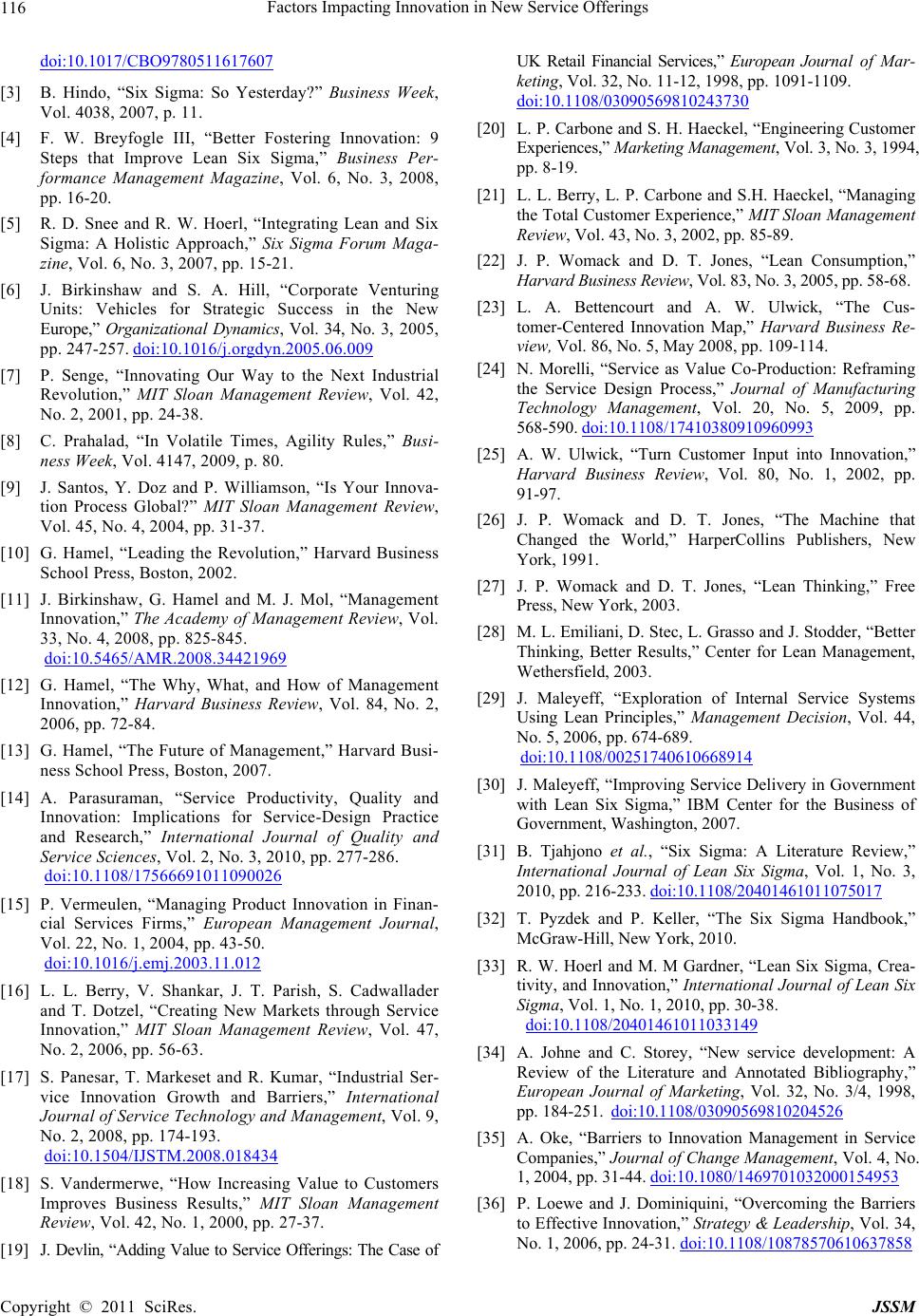
Factors Impacting Innovation in New Service Offerings
Copyright © 2011 SciRes. JSSM
116
doi:10.1017/CBO9780511617607
[3] B. Hindo, “Six Sigma: So Yesterday?” Business Week,
Vol. 4038, 2007, p. 11.
[4] F. W. Breyfogle III, “Better Fostering Innovation: 9
Steps that Improve Lean Six Sigma,” Business Per-
formance Management Magazine, Vol. 6, No. 3, 2008,
pp. 16-20.
[5] R. D. Snee and R. W. Hoerl, “Integrating Lean and Six
Sigma: A Holistic Approach,” Six Sigma Forum Maga-
zine, Vol. 6, No. 3, 2007, pp. 15-21.
[6] J. Birkinshaw and S. A. Hill, “Corporate Venturing
Units: Vehicles for Strategic Success in the New
Europe,” Organizational Dynamics, Vol. 34, No. 3, 2005,
pp. 247-257. doi:10.1016/j.orgdyn.2005.06.009
[7] P. Senge, “Innovating Our Way to the Next Industrial
Revoluti on, ” MIT Sloan Management Review, Vol. 42,
No. 2, 2001, pp. 24-38.
[8] C. Prahalad, “In Volatile Times, Agility Rules,” Busi-
ness Week, Vol. 4147, 2009, p. 80.
[9] J. Santos, Y. Doz and P. Williamson, “Is Your Innova-
tion Process Global?” MIT Sloan Management Review,
Vol. 45, No. 4, 2004, pp. 31-37.
[10] G. Hamel, “Leading the Revolution,” Harvard Business
School Press, Boston, 2002.
[11] J. Birkinshaw, G. Hamel and M. J. Mol, “Management
Innovation,” The Academy of Management Review, Vol.
33, No. 4, 20 08, pp. 8 25- 845 .
2U doi:10.5465/AMR.2008.34421969
[12] G. Hamel, “The Why, What, and How of Management
Innovation,” Harvard Business Review, Vol. 84, No. 2,
2006, pp. 72-84.
[13] G. Hamel, “The Future of Management,” Harvard Busi-
ness School Press, Boston, 2007.
[14] A. Parasuraman, “Service Productivity, Quality and
Innovation: Implications for Service-Design Practice
and Research,” International Journal of Quality and
Service Sciences, Vol. 2, No. 3, 2010, pp. 277-286.
4U doi:10.1108/17566691011090026
[15] P. Vermeulen, “Managing Product Innovation in Finan-
cial Services Firms,” European Management Journal,
Vol. 22, No. 1, 2004, pp. 43-50.
6U doi:10.1016/j.emj.2003.11.012
[16] L. L. Berry, V. Shankar, J. T. Parish, S. Cadwallader
and T. Dotzel, “Creating New Markets through Service
Innovation,” MIT Sloan Management Review, Vol. 47,
No. 2, 2006, pp. 56-63.
[17] S. Panesar, T. Markeset and R. Kumar, “Industrial Ser-
vice Innovation Growth and Barriers,” International
Journal of Service Technology and Management, Vol. 9,
No. 2, 2008, pp. 174-193.
8U doi:10.1504/IJSTM.2008.018434
[18] S. Vandermerwe, “How Increasing Value to Customers
Improves Business Results,” MIT Sloan Management
Review, Vol. 42, No. 1, 2000, pp. 27-37.
[19] J. Devlin, “Adding Value to Service Offerings: The Case of
UK Retail Financial Services,” European Journal of Mar-
keting, Vol. 32, No. 11-12, 1998, pp. 1091-1109.
1Udoi:10.1108/03090569810243730
[20] L. P. Carbone and S. H. Haeckel, “Engineering Customer
Experiences,” Marketing Management , Vol. 3, No. 3, 1994,
pp. 8-19.
[21] L. L. Berry, L. P. Carbone and S.H. Haeckel, “Managing
the Total Customer Experience,” MIT Sloan Management
Review, Vol. 43, No. 3, 2002, pp. 85-89.
[22] J. P. Womack and D. T. Jones, “Lean Consumption,”
Harvard Business Review, Vol. 83, N o. 3, 2005, pp. 58-68.
[23] L. A. Bettencourt and A. W. Ulwick, “The Cus-
tomer-Centered Innovation Map,” Harvard Business Re-
view, Vol. 86, No. 5, May 2008, pp. 109-114.
[24] N. Morelli, “Service as Value Co-Production: Reframing
the Service Design Process,” Journal of Manufacturing
Technology Management, Vol. 20, No. 5, 2009, pp.
568-590. doi:10.1108/17410380910960993
[25] A. W. Ulwick, “Turn Customer Input into Innovation,”
Harvard Business Review, Vol. 80, No. 1, 2002, pp.
91-97.
[26] J. P. Womack and D. T. Jones, “The Machine that
Changed the World,” HarperCollins Publishers, New
York, 1991.
[27] J. P. Womack and D. T. Jones, “Lean Thinking,” Free
Press, New York, 2003.
[28] M. L. Emiliani, D. Stec, L. Grasso and J. Stodder, “Better
Thinking, Better Results,” Center for Lean Management,
Wethersfield, 2003.
[29] J. Maleyeff, “Exploration of Internal Service Systems
Using Lean Principles,” Management Decision, Vol. 44,
No. 5, 2006, pp. 674-689.
1U doi:10.1108/00251740610668914
[30] J. Maleyeff, “Improving Service Delivery in Government
with Lean Six Sigma,” IBM Center for the Business of
Government, Washington, 2007.
[31] B. Tjahjono et al., “Six Sigma: A Literature Review,”
International Journal of Lean Six Sigma, Vol. 1, No. 3,
2010, pp. 216-233. doi:10.1108/20401461011075017
[32] T. Pyzdek and P. Keller, “The Six Sigma Handbook,”
McGraw-Hill, New York, 2010.
[33] R. W. Hoerl and M. M Gardner, “Lean Six Sigma, Crea-
tivity, and Innovation,” International Journal of Lean Six
Sigma, Vol. 1, No. 1, 2010, pp. 30-38.
1U doi:10.1108/20401461011033149
[34] A. Johne and C. Storey, “New service development: A
Review of the Literature and Annotated Bibliography,”
European Journal of Marketing, Vol. 32, No. 3/4, 1998,
pp. 184-251. 1U doi:10.1108/03090569810204526
[35] A. Oke, “Barriers to Innovation Management in Service
Companies,” Journal of Change Management, Vol. 4, No.
1, 2004, pp. 31-44. doi:10.1080/1469701032000154953
[36] P. Loewe and J. Dominiquini, “Overcoming the Barriers
to Effective Innovation,” Strategy & Leadership, Vol. 34,
No. 1, 2006, pp. 24-31. doi:10.1108/10878570610637858